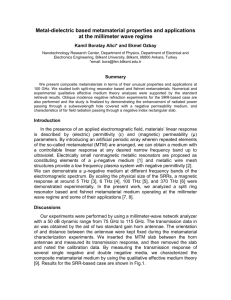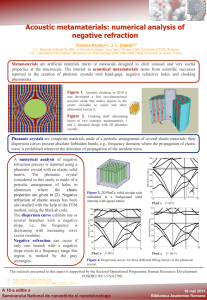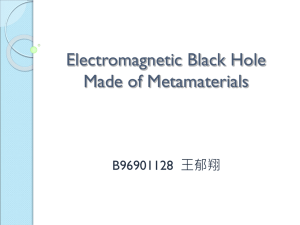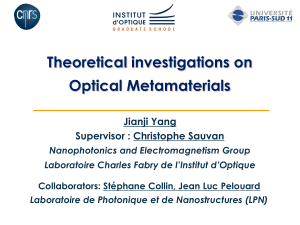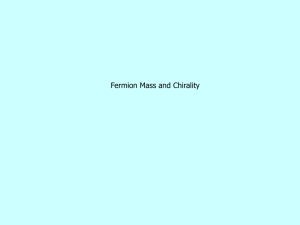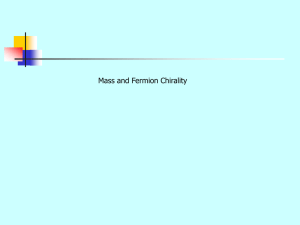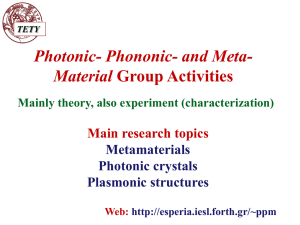Advisor: Prof. Ruey-Beei Wu Student : Hung
advertisement
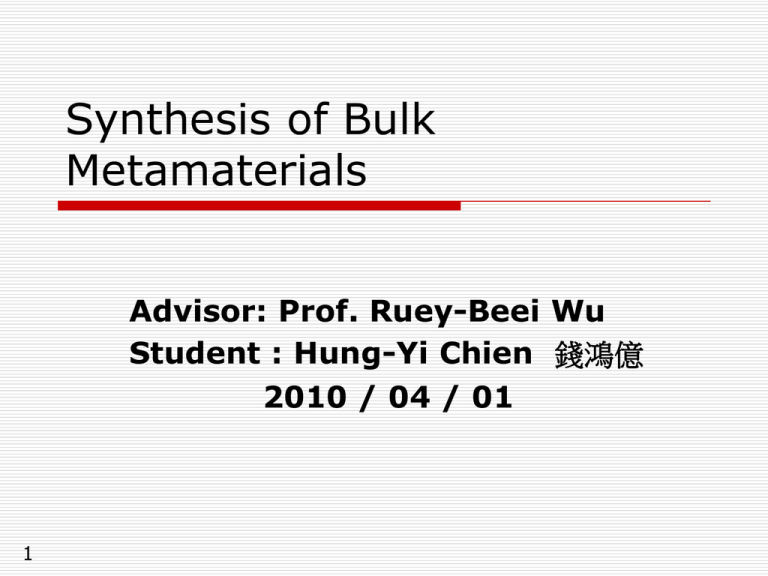
Synthesis of Bulk Metamaterials Advisor: Prof. Ruey-Beei Wu Student : Hung-Yi Chien 錢鴻億 2010 / 04 / 01 1 Outline 2 Introduction Scaling Plasma at Microwave Frequency Synthesis of Negative Magnetic Permeability SRR-Based Left-Handed Metamaterials Introduction Deisng of bulk metamaterials with negative parameters 3 A combination of unit cells of small electrical size at frequency of interest Periodicity A system of metallic wire and/or plates is used to obtain negative dielectric permittivity. A system of split ring resonators (SRRs) is used to obtain negative magnetic permeability. Scaling Plasmas at Microwave frequency Simulation of plasmas at microwave frequencies Became an active field of research during 1960s Simulation of radio-communications with spaceships during transit through the ionosphere Modeling of plasma: Systems of metallic wires [1] Plasmas Exhibit negative dielectric permittivity below plasma frequency Artificial media with negative dielectric permittivity[2] [1] W. Rotman “Plasma simulation by artificial dielectrics and parallel-plate media.” IRE Trans. Antennas Propag., vol. 10, pp. 82–95, 1962 [2] J. B. Pendry, A. J. Holden, W. J. Stewart, and I. Youngs “Extremely low frequency plasmons in metallic mesostructures.” Phys. Rev. Lett., vol. 76, pp. 4773–4776, 1996 4 Metallic Waveguide and Plates as 1D and 2-D Plasmas Consider a hollow rectangular waveguide (TE mode) Cutoff frequency Wave impedance Propagation constant Continuous media relations A rectangular waveguide 1-D plasma with effective dielectric constant Parallel metallic plates 5 2-D plasma with effective dielectric constant Wire Media If the period of the wire mesh is smaller than the freespace wavelength, it should be approximately equivalent to the bunch of waveguides. Consider a TEM transmission line loaded by metallic post Plasma frequency Approximation The cutoff frequency of waveguide bunch 6 More accurate determination Spatial Dispersion in Wire Media 7 Consider a set of periodic parallel infinite wires For TEM waves propagating perpendicular to the wires and polarized with magnetic field also perpendicular to the wires Dependence on kz Spatial dispersion is expected to appear when the unit cell size is not small with regard to the wavelength. Synthesis of Negative Magnetic Permeability Diamagnetism Current would be induced in the closed circuits under the effect of an external time-varying magnetic field. The secondary magnetic flux created by the induced current would be opposite to that created by the external fields. Closed metallic ring Self-inductance of a perfect conducting ring 8 Synthesis of Negative Magnetic Permeability It does not seen possible to obtain an effective negative permeability from the closed metallic ring. ( 9 , ) Capacitive loaded metallic loop Magnetic polarizability of a closed loop can be enhanced by loaded the loop with a capacitor. Show a negative permeability just above the resonant frequency Analysis of Edge-Coupled SRR EC-SRR Initially proposed by Pendry [3] Resonant frequency [3] J. B. Pendry, A. J. Holden, D. J. Robbins, and W. J. Stewart “Magnetism from conductors and enhanced nonlinear phenomena.” IEEE Trans. Microwave Theory Tech., vol. 47, pp. 2075–2084, 1999 10 Analysis of Edge-Coupled SRR EC-SRR Cross-polarizabilities Unwanted effect : bianisotropy [19] R. Marque´s, F. Mesa, J. Martel, and F. Medina “Comparative analysis of edge and broadside coupled split ring resonators for metamaterial design. Theory and experiment.” IEEE Trans. Antennas Propag., vol. 51, pp. 2572–2581, 2003. 11 Analysis of Edge-Coupled SRR The frequency of resonance of an EC-SRR can be measured by placing the EC-SRR inside a rectangular waveguide and measuring the transmission coefficient. Electric and magnetic excitation magnetic excitation electric excitation no excitation 12 Other SRR Designs Broadside-coupled SRR (BC-SRR) Avoid the EC-SRR bianisotropy Inversion symmetry Additional advantage of much smaller electrical length 13 The capacitance for the BC-SRR approximately corresponds to a parallel plate capacitor. Thin substrate of high permeability can be used. Other SRR Designs Broadside-coupled SRR (BC-SRR) 14 Other SRR Designs Nonbianisotropy SRR (NB-SRR) Avoid EC-SRR bianisotropy Inversion symmetry 15 Keep a uniplanar design Resonant frequency Other SRR Designs Double-split SRR (2-SRR) Avoid EC-SRR bianisotropy Inversion symmetry 16 The total capacitance of the circuit is four times smaller than for the conventional EC-SRR. Resonant frequency: twice the frequency of resonance of an EC-SRR Larger electrical size at resonance Other SRR Designs Spirals Resonant frequency: half the frequency of resonance of an EC-SRR Smaller electrical size at resonance Present some degree of bianisotropy [25] R. Marque´s, J. D. Baena, J. Martel, F. Medina, F. Falcone, M. Sorolla, and F. Martin “Novel small resonant electromagnetic particles for metamaterial and filter design.” Proc. ICEAA’03, pp. 439–442, Torino, Italy, 2003 17 Constitutive Relationship for Bulk SRR Metamaterials Effective constitutive parameters 18 The only necessary condition is that the size of the unit cell must be smaller than the wavelength. Constitutive Relationship for Bulk SRR Metamaterials Zero-order appoximation 19 Ignore couplings between adjacent elements A rough approximation Constitutive Relationship for Bulk SRR Metamaterials Lorentz appoximation 20 couplings between adjacent elements are considered in a rather simple way (Lorentz local field theory) Better approximation Array of EC-SRR Array of BC-SRR Higher-Order Resonances in SRRs Current distribution : symmetry or antisymmetry 21 Resonance of NB-SRR Resonance of EC-SRR SRR-Based Left-Handed Metamaterials 1-D SRR-based left-handed metamaterials Negative permittivity of the wire system Negative permeability of the SRR system [4] D. R. Smith, W. J. Padilla, D. C. Vier, S. C. Nemat-Nasser, and S. Schultz “Composite medium with simultaneously negative permeability and permittivity.” Phys. Rev. Lett., vol. 84, pp. 4184–4187, 2000. 22 SRR-Based Left-Handed Metamaterials 1-D SRR-based left-handed metamaterials A single row of SRRs is placed inside a cutoff square waveguide Negative permittivity: the cutoff waveguide Negative permeability: EC-SRR [46] R. Marque´s, J. Martel, F. Mesa, and F. Medina “Left-handed-media simulation and transmission of EM waves in subwavelength split-ring-resonator-loaded metallic waveguides.” Phys. Rev. Lett., vol. 89, paper 183901, 2002 23 SRR-Based Left-Handed Metamaterials 1-D SRR-based left-handed metamaterials Two hollow waveguides (one above and the other below cutoff) are loaded by equispaced BC-SRRs Passband : narrow waveguide Stopband : wider waveguide [51] J. D. Baena, R. Marque´s, J. Martel, and F. Medina “Experimental results on metamaterial simulation using SRRloaded waveguides.” Proc. IEEE-AP/S Int. Symp. on Antennas and Propagation, pp. 106–109, 2003 24 SRR-Based Left-Handed Metamaterials 2-D SRR-based left-handed metamaterials An orthogonal arrangement of dielectric circuit boards with EC-SRRs and metallic strips printed on each side Negative permittivity : metallic strips Negative permeability : EC-SRRs [50] R. Marque´s, J. Martel, F. Mesa, and F. Medina “A new 2-D isotropic left-handed metamaterial design: theory and experiment.” Microwave Opt. Tech. Lett., vol. 35, pp. 405–408, 2002. [52] R. A. Shelby, D. R. Smith, S. C. Nemat-Nasser, and S. Schultz “Microwave transmission through a twodimensional, isotropic, left-handed metamaterial.” Appl. Phys. Lett., vol. 78, pp. 489–491, 2001 25 SRR-Based Left-Handed Metamaterials Superposition 26 Systems providing negative permittivity and negative permeability should be placed in the way that the interaction between its elements through its quasistatic fields is minimized.
